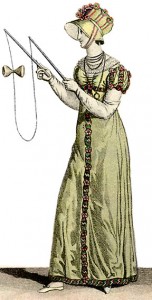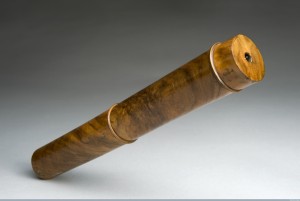by Helen King (Monthly Contributor)
No, this isn’t a telescope, it’s a stethoscope. René Laennec (1781-1826) invented this device in 1816, as a way to solve the ethical dilemma of having to put his ear to the chest of a young woman patient. He started with a rolled up piece of paper to help him hear her heart and her breathing, but then developed a wooden device. We are now most familiar with the binaural – two ears – stethoscope, but the earliest examples, like this one, were monaural.
The label ‘stethoscope’ suggests ‘looking at the chest’, on the model of ‘telescope’ – looking at something far off – or ‘microscope’ – looking at something very small. But, of course, this isn’t a visual device: it’s about a different sensory mode of knowing the body. Like any new piece of medical technology, it wasn’t an instant success, because physicians needed to be trained to identify what they heard. One of the sounds they heard clearly with the stethoscope came to be known as ‘le bruit de diable’, ‘the devil’s sound’. It was described by Richard Cabot in 1908 as ‘a soft, continuous humming heard by the stethoscope over the veins of the neck’. Today it’s more likely to be called a ‘venous hum’. It’s generally harmless.
So why ‘the devil’s sound’? Earlier imagery for this special background hum had been more benign. Walter Johnson described it in 1849 as like the sound of the sea heard when putting a shell to one’s ear. He wrote that, at Guy’s Hospital, the sound was called the ‘tearing-cotton murmur’. Most poetically of all, in 1872 Armand Trousseau wrote of a sound like ‘the purring of a cat when it is being caressed, or the noise of a spinning-wheel’.
So, why the devil? When I first wrote about this sound, in my book The Disease of Virgins, I assumed that the devil’s presence was heralded by a strange humming noise. Wrong! I’ve now found a piece in The London Medical and Surgical Journal for 1836 which makes it all clear. In a short guide to chest sounds ‘M.R.’ explains that direct listening to the chest is difficult because the friction of the physician’s head on the patient’s body can confuse the sounds. He helpfully tells us that ‘many persons are agitated by the use of the stethoscope’, so the physician should wait until they calm down again. He explains different sounds such as the ‘mucous rattle’ and the ‘crepitant rattle’, or wheeze, and tells the reader both what they resemble and what they mean. In another article, ‘R.’ describes how the condition of the heart can be understood by listening to it, and in particular describes the bruit de diable as an ‘intense degree’ of an arterial sound called bruit de soufflet. The ‘diable’ here, he explains, is from a sport which ‘consists in igniting a train of gunpowder or some other inflammable matter, which gives a continuous whizzing sound, according to some; and to the noise of a humming-top, according to others’.
 So it’s not about the devil at all. One variation of the humming top is still known to us as the diabolo. The two different explanations for the use of this label for the sound are interesting because they show how hard it is to create analogies for something we hear. Thanks to the wonders of the internet, you can hear it for yourself. To me, the ‘bruit de diable’ sounds quite different from the ‘continuous whizzing’ of a gunpowder trail igniting, and not much like a top either; I’d say it sounds like static on a radio or TV, but of course both of these technologies were still a long way away in 1836. Hearing the sounds of the body is far from straightforward, and sharing what you hear depends on a common knowledge of sounds – which in turn will inevitably depend on your culture!
So it’s not about the devil at all. One variation of the humming top is still known to us as the diabolo. The two different explanations for the use of this label for the sound are interesting because they show how hard it is to create analogies for something we hear. Thanks to the wonders of the internet, you can hear it for yourself. To me, the ‘bruit de diable’ sounds quite different from the ‘continuous whizzing’ of a gunpowder trail igniting, and not much like a top either; I’d say it sounds like static on a radio or TV, but of course both of these technologies were still a long way away in 1836. Hearing the sounds of the body is far from straightforward, and sharing what you hear depends on a common knowledge of sounds – which in turn will inevitably depend on your culture!

